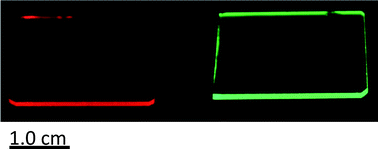Luminescent coatings from bipyridine-based bridged silsesquioxanes containing Eu3+ and Tb3+ salts†
Abstract
The sol–gel fabrication of bridged

Maintenance work is planned from 09:00 BST to 12:00 BST on Saturday 28th September 2024.
During this time the performance of our website may be affected - searches may run slowly, some pages may be temporarily unavailable, and you may be unable to access content. If this happens, please try refreshing your web browser or try waiting two to three minutes before trying again.
We apologise for any inconvenience this might cause and thank you for your patience.
* Corresponding authors
a
Institut Charles Gerhardt Montpellier (UMR 5253 CNRS-UM2-ENSCM-UM1), 8, rue de l'école normale, 34296 Montpellier, France
E-mail:
michel.wong-chi-man@enscm.fr
b
Department of Physics and CICECO, Universidade de Aveiro, 3810-193 Aveiro, Portugal
E-mail:
lcarlos@ua.pt
c Instituto de Telecomunicações and Department of Physics, Universidade de Aveiro, 3810-193 Aveiro, Portugal
d School of Science and Health, University of Western Sydney, Locked Bag 1797, Penrith, NSW 2751, Australia
e
Faculty of Science, Health, Education and Engineering, University of the Sunshine Coast, Maroochydore DC, QLD 4558, Australia
E-mail:
JBartlett@usc.edu.au
The sol–gel fabrication of bridged

 Please wait while we load your content...
Something went wrong. Try again?
Please wait while we load your content...
Something went wrong. Try again?
J. Graffion, A. M. Cojocariu, X. Cattoën, R. A. S. Ferreira, V. R. Fernandes, P. S. André, L. D. Carlos, M. Wong Chi Man and J. R. Bartlett, J. Mater. Chem., 2012, 22, 13279 DOI: 10.1039/C2JM31289A
To request permission to reproduce material from this article, please go to the Copyright Clearance Center request page.
If you are an author contributing to an RSC publication, you do not need to request permission provided correct acknowledgement is given.
If you are the author of this article, you do not need to request permission to reproduce figures and diagrams provided correct acknowledgement is given. If you want to reproduce the whole article in a third-party publication (excluding your thesis/dissertation for which permission is not required) please go to the Copyright Clearance Center request page.
Read more about how to correctly acknowledge RSC content.
 Fetching data from CrossRef.
Fetching data from CrossRef.
This may take some time to load.
Loading related content
